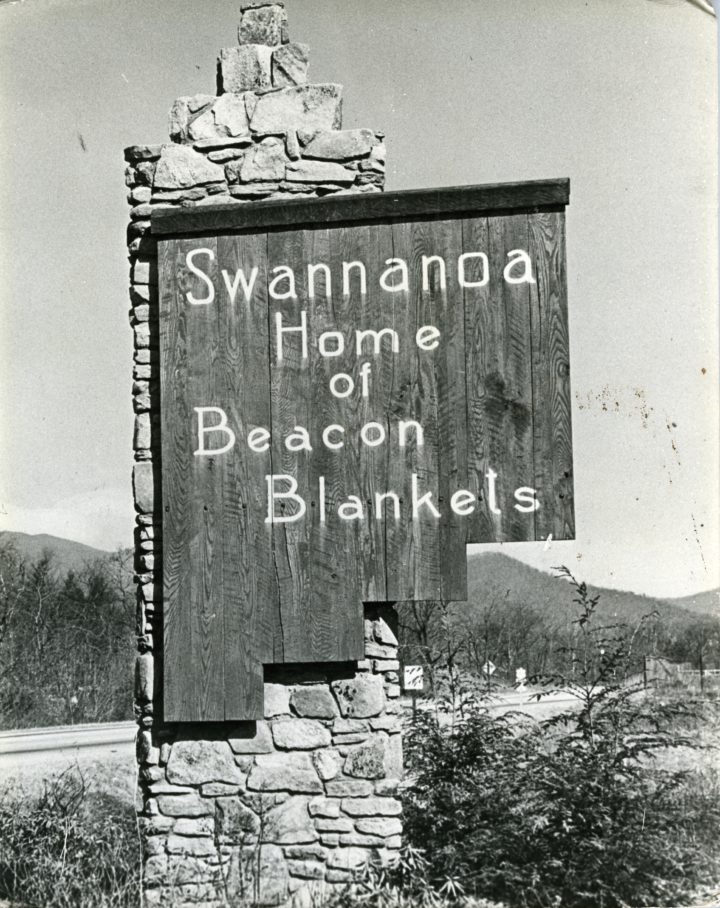Swannanoa Valley Museum honors Beacon blankets

Rebecca Williams was asleep inside her Grovemont home, unaware of the conflagration that illuminated the early morning sky. Her husband, Jerry Pope, woke her up to share the news: The former Beacon Manufacturing Co. plant was on fire.
It was 4 a.m. on Sept. 3, 2003, and Williams was suddenly wide awake. “We could see the flames above the tree line,” she remembers.
The couple soon made their way to the corner of Whitson Avenue and Old Highway 70 in Swannanoa. A pre-dawn crowd had gathered to watch fire crews battle the blaze. Ultimately, however, the flames won out, transforming the former mill into a heap of smoking rubble.
Williams, who was still relatively new to the area back then, says she didn’t fully grasp the significance of the structure’s demise. The plant had been closed for over a year. But like many other community members, she found herself repeatedly returning to the ruins in the months that followed.
“People would come to the site, and you could see them crying and collecting bricks,” she recalls. “I didn’t know what was going on, but I knew that something really important was happening.”
As former Beacon employees and other residents continued to mourn the loss, Williams began collecting stories. Although she didn’t know it at the time, the material would ultimately become the basis for a documentary, Blanket Town, which Williams hopes to wrap up later this year. The film spans the Swannanoa mill’s entire history, from its beginnings in 1924 to its closing in 2002 and subsequent destruction.
Excerpts from the documentary in progress will be featured as part of the Swannanoa Valley Museum & History Center’s latest exhibit, Beacon Blankets: The Mill. Informational panels, photographs and memorabilia will also be on display. The free exhibit opens Saturday, April 13, and runs through Friday, Nov. 1.
“Like all companies, Beacon had its ups and downs,” says Anne Chesky Smith, the museum’s director. At its peak, it brought thousands of manufacturing and management jobs to the area. At the same time, she continues, Beacon also embodied many of the social evils prevalent in the Jim Crow South. “But it was a community, and I think that’s one of the important things. Beacon was Swannanoa. Everything that was in Swannanoa was entangled in Beacon.”
Charles, Charles and Charles
In 1885, there were 60 textile mills operating in North Carolina, the Beacon exhibit notes. By 1915, that number had soared to 318, as Northern companies headed south seeking milder climates, cheaper labor and better access to such resources as water, timber and cotton.
It wasn’t long before Beacon followed suit. In 1904, Charles Dexter Owen I, his son Charles Dexter Owen II and their cousin Charles Owen Dexter had acquired the defunct New Bedford, Mass.-based company. At the time, Beacon was known for spinning yarn from waste.
Within a year, however, the company had begun producing cotton flannel fabric used for robes and blankets. Twenty employees made up the payroll in 1905. By 1912, the company had an army of 800 workers. And in 1923, the same year that North Carolina became the nation’s No. 1 textile producer, Beacon boasted 1,600 employees.
Needing to expand to accommodate its explosive growth, the family-owned business turned its attention southward in 1924. The new Swannanoa facility transformed raw cotton and wool into blankets that were then sold directly to retailers.
Within a decade, Beacon had relocated its entire operation to the North Carolina site, in the midst of the Great Depression. A key factor, notes Chesky Smith, was the ever-growing presence of union activity in New Bedford. At the Southern factory, similar activity was noticeably absent.
When the new 1 million-square-foot plant was completed in 1936, Beacon became the world’s largest mill, the exhibit notes. At its peak, the giant factory employed 2,200 people.
Village life
Both Williams’ forthcoming documentary and the upcoming museum exhibit spotlight life in Beacon’s mill villages. Common throughout much of the country, these worker communities were owned by the companies that built them and rented out the residential units to their employees. In 1900, over 90 percent of textile workers lived in such places, according to the American Historical Association.

Part of the intent, says Chesky Smith, was to discourage workers from unionizing. “Everything was connected,” she points out. “If you lose your job, you lose your housing.”
Nonetheless, many former residents speak fondly of their time in the villages, Williams and Chesky Smith stress. Workers maintained both community and individual gardens. Doors were often left unlocked. And the Owens let employees keep hogs and cows in designated areas.
Swannanoa, too, thrived during Beacon’s heyday. “We had a department store, we had a furniture store. … We had a theater and … two drugstores,” Joan Barnwell recalled in a 2012 interview.
“Oh, the town was fun!” gushed former resident Utha Aiken in an interview conducted that same year. In addition, she noted, the Owen family organized both a barbecue and a ball for their employees each year.
Williams, who interviewed more than 90 people associated with the mill for her film, shares the former villagers’ enthusiasm. “It was a bustling, lively place,” she exclaims, “and a way of life that doesn’t exist anymore.”
Segregation and cultural appropriation
It wasn’t all good clean fun, however. As in much of the pre-civil rights movement South, African American employees were restricted to the lowest-paying menial jobs and were not allowed to live in Beacon’s mill villages.
But while the company’s mistreatment of its black workers wouldn’t begin to shift until the 1960s, its deceptive advertising had already sparked controversy decades before.
On Nov. 3, 1930, the Federal Trade Commission and the Navajo Indian Nation accused Beacon of misleading consumers with its latest campaign. The ads depicted Native Americans hand-weaving some of the company’s blankets, which were described as “Indian woven.”
On June 28, 1932, the commission ordered Beacon to reword the ads to read “Indian design blankets.”
Final nail in the coffin
These difficult issues are only two of the many topics that both the exhibit and Williams’ documentary examine, including a more positive exploration of Beacon’s role during World War II. Of the company’s 2,200 employees, 930 served in the conflict. All told, Beacon produced over 7 million blankets for the troops.
Blanket Town, says the filmmaker, is very much a story for and about the Swannanoa Valley. Yet the narrative also presents Swannanoa as an exemplar of small, rural towns across America and particularly Appalachia. “It’s the story of industrialization and its impact, and the pain and loss of that industry,” says Williams.
Prior to the fire, she points out, many community members still hoped that Beacon might one day return, or perhaps that another industry would take over the space, bringing with it the next wave of manufacturing jobs. But when a teenage vandal set the structure ablaze, all hope was lost.
“The fire was the nail in the coffin,” says Williams. “It was the end of an era.”
The Beacon exhibit, however, describes a much more gradual decline that was set in motion as far back as 1969, when the Owen family sold the last of their company stock. Over the next three decades, several different corporations tried their hand at profitably operating the plant. Finally, in 2001, a group of private investors bought the company and, on April 15, 2002, shut it down, leaving 300 community members unemployed.
Williams doesn’t dispute this perspective, saying that her film is also a cautionary tale about absentee ownership and the adverse effects corporations can have on local communities. But if the Beacon model included its fair share of paternalism, “At least there was a relationship between its owners and the community,” notes the filmmaker.
“As corporations get more and more global and less and less connected, their relationship is with the stockholders,” she continues. “It is not with the people who are doing the work and not with the community that they’re in.”
For many people, says Williams, Beacon was the pulse of Swannanoa. When it was doing well, the rest of the community was too. Ultimately, the question her film seeks to answer is “What happens when you take the heart out of a town?”
The Swannanoa Valley Museum & History Center’s latest exhibit, Beacon Blankets: The Mill opens Saturday, April 13, and will run through Friday, Nov. 1.
History Café
Along with the Beacon exhibit, the Swannanoa Valley Museum & History Center will be introducing the History Café. On the fourth Monday of each month from 10:30-11:30 a.m., local historians will present talks on significant regional figures and events. The free monthly series, which will run April-October, will feature complimentary coffee from Dynamite Roasting Co. The inaugural talk, on April 22, will be led by local filmmaker Rebecca Williams, who’ll discuss her forthcoming documentary, Blanket Town.
To learn more, visit avl.mx/5up





No comments:
Post a Comment